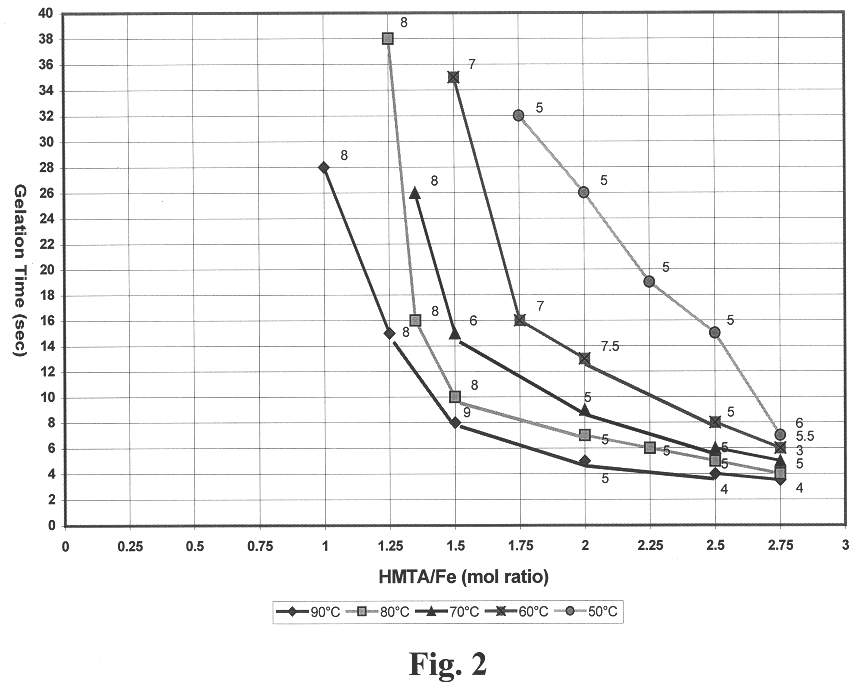Method for preparing hydrous iron oxide gels and spherules
a technology of hydrous iron oxide gel and spherule, which is applied in the direction of iron compounds, phosphorus oxyacids, chemistry apparatus and processes, etc., can solve the problems of poor hydrodynamic properties, inability to adapt to continuous processing, and inability of binders to reduce the number of exchange sites available, so as to facilitate the removal of gels, remove any reaction impurities, and easy to wash
- Summary
- Abstract
- Description
- Claims
- Application Information
AI Technical Summary
Benefits of technology
Problems solved by technology
Method used
Image
Examples
example 2
Broths were prepared in which the iron in the feed stock solution was partially hydrolyzed with NH.sub.4 OH to provide an OH.sup.- / Fe.sup.+3 mole ratio of 0.5. The HMTA concentration of the broths ranged from 0.8 to 2.2 M. The iron concentration of the broths ranged from 0.9 to 2.1 M. In this range of concentrations, the heated broths gelled between 4 and 34 seconds. FIG. 3 gives the gelation initiation time as a function of HMTA / Fe mole ratio and temperature. Good gel formation was obtained with certain broths at each of the temperatures. Broths with HMTA / Fe mole ratios of 1 or less gelled too slowly or would not gel at all. Broths prepared with HMTA / Fe mole ratio of 3 were not stable and could not be tested. FIG. 3 also gives the degree of rigidity as defined by the collins scale. These data show that an HMTA / Fe mole ratio of 1 or greater is needed for a broth to have gel times of 30 seconds or less. Higher forming temperatures also allow broths with less HMTA and urea to be used...
example 3
Broths were prepared in which the iron in the feed stock solution was partially hydrolyzed with NH.sub.4 OH to provide an OH.sup.- / Fe.sup.+3 mole ratio of 1.0. The HMTA concentration of the broths ranged from 0.8 to 2.2 M. The iron concentration of the broths ranged from 0.9 to 2.1 M. In this range of concentrations, the heated broths gelled between 4 and 32 seconds. FIG. 4 gives the gelation initiation time as a function of HMTA / Fe mole ratio and temperature. Good gel formation was obtained with certain broths at each of the temperatures. Broths with HMTA / Fe mole ratios of 1 or less gelled too slowly or would not gel at all. Broths prepared with HMTA / Fe mole ratio of 3 were not stable and could not be tested. FIG. 4 also gives the degree of rigidity as defined by the collins scale. These data show that an HMTA / Fe mole ratio of 0.75 or greater is needed for a broth to have gel times of 30 seconds or less. Higher forming temperatures also allow broths with less HMTA and urea to be u...
example 4
Broths were prepared in which the iron in the feed stock solution was partially hydrolyzed with NH.sub.4 OH to provide an OH.sup.- / Fe.sup.+3 mole ratio of 1.5. The HMTA concentration of the broths ranged from 0.4 to 1.3 M. The iron concentration of the broths ranged from 1.3 to 2.2 M. In this range of concentrations, the heated broths gelled between 5 and 39 seconds. FIG. 5 gives the gelation initiation time as a function of HMTA / Fe mole ratio and temperature. Good gel formation was obtained with certain broths at each of the temperatures. Broths prepared with HMTA / Fe mole ratio of land greater were not stable and could not be tested. FIG. 5 also gives the degree of rigidity as defined by the collins scale. These data show that an HMTA / Fe mole ratio of 0.15 or greater is needed for a broth to have gel times of 30 seconds or less. Higher forming temperatures also allow broths with less HMTA and urea to be used to obtained the more ideal gelation time of 15 seconds or less, and these...
PUM
| Property | Measurement | Unit |
|---|---|---|
| temperature | aaaaa | aaaaa |
| mole ratio | aaaaa | aaaaa |
| temperature | aaaaa | aaaaa |
Abstract
Description
Claims
Application Information
 Login to View More
Login to View More - R&D
- Intellectual Property
- Life Sciences
- Materials
- Tech Scout
- Unparalleled Data Quality
- Higher Quality Content
- 60% Fewer Hallucinations
Browse by: Latest US Patents, China's latest patents, Technical Efficacy Thesaurus, Application Domain, Technology Topic, Popular Technical Reports.
© 2025 PatSnap. All rights reserved.Legal|Privacy policy|Modern Slavery Act Transparency Statement|Sitemap|About US| Contact US: help@patsnap.com



